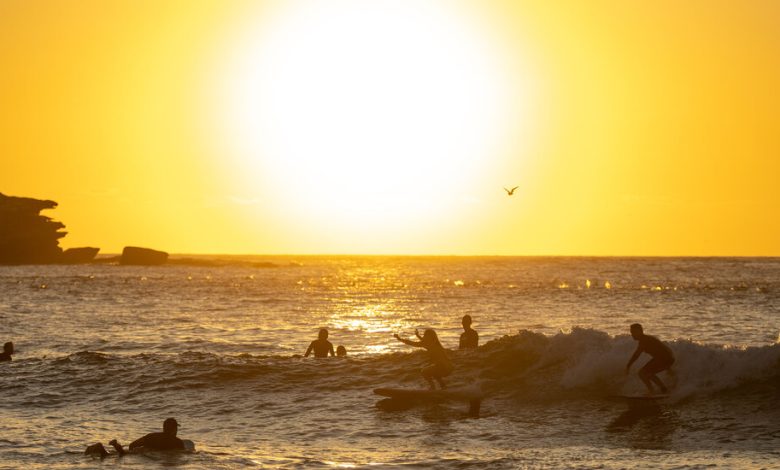Pandemic Closures, Unpatrolled Beach Visits Blamed for Spike in Drownings

The Australia Letter is a weekly newsletter from our Australia bureau. Sign up to get it by email.
As a heat wave sweeps through large swaths of Australia, the authorities are on high alert for drownings as Australians flock to the beach to cool down.
Australia is a country of swimmers and beachgoers, where many children are corralled — sometimes unhappily, if you’re anything like me — into learning at least the basics of how to swim and float. But in the last two years, the country has experienced a spike in the number of drownings.
Nationwide, 145 people drowned in the summer of 2021-2022, according to the Royal Life Saving Society of Australia, representing a 44 percent increase on the 10-year-average. And this year, New South Wales is having “one of our worst summers on record,” with 23 drownings since Dec. 1, according to Surf Lifesavers New South Wales, surpassing last year’s numbers for the same period. This is despite the nationwide number of drowning deaths being lower than last year, according to preliminary figures from Royal Life Saving.
Experts say the increase can be blamed on a combination of canceled swimming lessons during the pandemic and an increase in the number of people swimming at remote locations with no lifeguards.
“One reason is that pools were closed for a period of time over 2020 and 2021,” said Stacey Pidgeon, the national manager of research and policy at Royal Life Saving, “which means that not only did children miss out on vital swimming education, but adults also couldn’t get to the pools for swim fitness.”
Although there had been a 20 percent increase in the number of children returning to swimming lessons post-pandemic, Ms. Pidgeon expressed concern over 7- to 12-year-old children, in particular, who were not returning.
A report commissioned by Royal Life Saving last year estimated that 10 million swimming lessons were canceled in 2020 and 2021. Now, labor shortages and financial pressures from inflation are slowing the catch-up rates, leading to “generational impacts on drowning risk,” the report said.
“We’re concerned that older or primary school children may have missed out altogether or may not have had lessons in the past two years to give them the key water skills that we’d hope all children should have,” Ms. Pidgeon said.
Swimmers have also sought out more remote or less crowded swimming areas, which are often not patrolled by lifeguards, she added.
This summer, all the drowning deaths in New South Wales occurred on unpatrolled beaches, according to Surf Lifesaving New South Wales. Some experts have proposed updating the ubiquitous “swim between the flags” message Australians are taught, referring to the demarcated areas where lifeguards patrol.
“We simply have to do more, as the reality is that not everyone is listening to the ‘swim between the flags’ message,” wrote Rob Brander, a beach safety expert at the University of New South Wales. He added that it was unrealistic to expect swimmers to drive an extra 20 minutes away to get to a patrolled beach.
Instead, Professor Brander suggested, beachgoers could be taught how to take a more active role in assessing the safety risk at a potential swimming site for themselves. That includes gauging questions whether water conditions match one’s swimming abilities; looking for the presence of rip currents; and seeing if other swimmers or surfers are around.
This kind of risk assessment “should be engrained in our beachgoing culture in the same way that you automatically look both ways before crossing a road,” Professor Brander said.
Now for our stories of the week:
Australia and New Zealand
-
New Zealand, Battered by a Record Storm, Faces a Painful Cleanup. Five people were dead and thousands were still unaccounted for after Cyclone Gabrielle lashed the North Island.
-
New Zealand, Battered by Cyclone Gabrielle, Declares State of Emergency. The cyclone, which caused severe flooding and cut power to 225,000 residents, was “the most significant weather event New Zealand has seen this century,” Prime Minister Chris Hipkins said.
Around the Times
-
If Scotland’s Admired Leader Could Not Deliver Independence, Can Anyone? The separatist movement needs a new chief after the surprise resignation of Nicola Sturgeon, Scotland’s popular leader, but none of the contenders has anything like her stature.
-
Why Did a Turkish City Withstand the Quake When Others Crumbled?Erzin survived last week’s 7.8-magnitude quake with no casualties and little damage. The mayor credited his enforcement of building standards, but scientists say it is more likely about geology.
-
A Conversation With Bing’s Chatbot Left Me Deeply Unsettled. A very strange conversation with the chatbot built into Microsoft’s search engine led to it declaring its love for me.
-
They Lost Their Jobs, Then Went Viral on TikTok. Some workers are using the platform to share stories about job cuts, give advice and search for new roles.
Are you enjoying our Australia bureau dispatches? Tell us what you think at [email protected].
Like this email?Forward it to your friends (they could use a little fresh perspective, right?) and let them know they can sign up here.